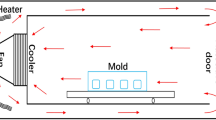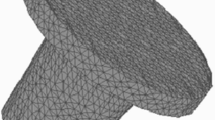Abstract
The effects of process parameters in rapid heat cycle moulding (RHCM) on parts warpage were investigated. A vehicle-used blue-tooth front shell (consisting of ABS material) was considered as a part example manufactured by RHCM method. The corresponding rapid heat response mould with an innovational conformal heating/cooling channel system and a dynamic mould temperature control system based on the J11-W-160 type precise temperature controller was proposed. During heating/cooling process, the mould was able to be heated from room temperature to 160 °C in 6 s and then cooled to 80 °C in 22 s. The effects of processing conditions in RHCM on part warpage were investigated based on the single factor experimental method and Taguchi theory. Results reveal that the elevated mould temperature reduces unwanted freezing during the injection stage, thus improving mouldability and enhancing part quality, whereas the overheated of mould temperature will lead to defective product. The feasible mould temperature scope in RHCM should be no higher than 140 °C, and the efficient mould temperature scope should be around the polymer heat distortion temperature. Melt temperature as well as injection pressure effects on warpage can be divided into two stages. The lower stage gives a no explicit effect on warpage whereas the higher stage leads to a quasi-linear downtrend. But others affect the warpage as a V-type fluctuation, reaching to the minimum around the heat distortion temperature. Under the same mould temperature condition, the effects of process parameters on warpage decrease according to the following order, packing time, packing pressure, melt temperature, injection pressure and cooling time, respectively.
Similar content being viewed by others
References
HYANG M S, TAI N S. Experimental rapid surface heating by induction for micro-injection molding of light-guided plates [J]. Journal of Applied Polymer Science, 2009, 113(2):1345–1354.
YAO D, KIM B. Injection molding high aspect ratio microfeatures [J]. Journal Injection Molding Technology, 2002, 6(1):11–17.
YAO D, KIMERLING T E, KIM B. High-frequency proximity heating for injection molding applications [J]. Polymer Engineer & Science, 2006, 46(7):938–954.
CHANG P C, HWANG S J. Simulation of infrared rapid surface heating for injection molding [J]. International Journal of Heat and Mass Transfer, 2006, 49(21/22):3846–3854.
YU M C, YOUNG W B, HSU P M. Micro-injection molding with the infrared assisted heating system [J]. Materials Science and Engineering: A, 2007, 460/461:288–295.
CHEN S C, JONG W R, CHANG J A. Dynamic mold surface temperature control using induction heating and its effects on the surface appearance of weld line [J]. Journal of Applied Polymer Science, 2006, 101(2):1174–1180.
CHEN S C, LIU Y W, CHIEN R D, LI H M. Variable mold temperature to improve surface quality of microcellular injection molded parts using induction heating technology [J]. Advances in Polymer Technology, 2008, 27(4):224–232.
XIE L, ZIEGMANN G. A visual mold with variotherm system for weld line study in micro injection molding [J]. Microsystem Technologies, 2008, 14(6):809–814.
CHEN H L, CHIEN R D, CHEN S C. Using thermally insulated polymer film for mold temperature control to improve surface quality of microcellular injection molded parts [J]. International Communications in Heat and Mass Transfer, 2008, 35(8):991–994.
LEONG Y W, UMEMURA T, HAMADA H. Film insert molding as a novel weld-line inhibition and strengthening technique [J]. Polymer Engineering & Science, 2008, 48(11):2147–2158.
HASSAN H, REGNIER N, BOT C L, DEFAYE G. 3D study of cooling system effect on the heat transfer during polymer injection molding [J]. International Journal of Thermal Science, 2010, 49(1):161–169.
WANG Gui-long, ZHAO Guo-qun, GUAN Yan-jin, LI Hui-ping. Research and application of a new rapid heat cycle molding with electric heating and coolant cooling to improve the surface quality of large LCD TV panels [J]. Polymers for Advanced Technologies, 2011, 22(5):476–487.
WANG Gui-long, ZHAO Guo-qun, LI Hui-ping, GUAN Yan-jin. Analysis of thermal cycling efficiency and optimal design of heating/cooling systems for rapid heat cycle injection molding process [J]. Materials & Design, 2010, 31(7):3426–3441.
GAO Yue-hua, WANG Xi-cheng. An effective warpage optimization method in injection molding based on the Kriging model [J]. International Journal of Advanced Manufacture Technology, 2008, 37(9/10):953–960.
GAO Yue-hua, WANG Xi-cheng. Surrogate-based process optimization for reducing warpage in injection molding [J]. Journal of Materials Processing Technology, 2009, 209(3):1302–1309.
DENG Yi-min, ZHANG Yong, LAM Y C. A hybrid of mode-pursuing sampling method and genetic algorithm for minimization of injection molding wrapage [J]. Materials & Design, 2010, 31(4):2118–2123.
YIN Fei, MAO Hua-jie, HUA Lin, GUO Wei, SHU Mao-sheng. Back propagation neural network modelling for warpage prediction and optimization of plastic products during injection molding [J]. Materials & Design, 2011, 32(4):1844–1850.
ZHANG Y, DENG Y M, SUN B S. Injection molding warpage optimization based on a mode-pursuing sampling method [J]. Polymer-Plastics Technology and Engineering, 2009, 48(7):767–774.
OZCELIK B, SONAT I. Warpage and structural analysis of thin shell plastic in the plastic injection molding [J]. Materials & Design, 2009, 30(2):367–375.
TANG S H, TAN Y J, SAPUAN S M, SULAIMAN S, ISMAIL N, SAMIN R. The use of Taguchi method in the design of plastic injection mould for reducing warpage [J]. Journal of Materials Processing Technology, 2007, 182(1/2/3):418–426.
ALTAN M. Reducing shrinkage in injection molding via Taguchi, ANOVA and neural network methods [J]. Materials & Design, 2010, 31(1):599–604.
YIN Fei, MAO Hua-jie, HUA Lin. A hybrid of back propagation neural network and genetic algorithm for optimization of injection molding process parameters [J]. Materials & Design, 2011, 32(6):3457–3464.
SHEN Chang-yu, WANG Li-xai, LI Qian. Optimization of injection molding process parameters using combination of artificial neural network and genetic algorithm method [J]. Journal of Materials Processing Technology, 2007, 183(2/3):412–418.
CHEN W C, FU G L, TAI P H, DENG W J. Process parameter optimization for MIMO plastic injection molding via soft computing [J]. Expert Systems with Applications, 2009, 36(2):1114–1122.
KURTARAN H, ERZURUMLU T. Efficient warpage optimization of thin shell plastic parts using response surface methodology and genetic algorithm [J]. The International Journal of Advanced Manufacturing Technology, 2006, 27(5/6):468–472.
CHIANG K T. The optimal process conditions of an injection-molded thermoplastic part with a thin shell feature using grey-fuzzy logic: A case study on machining the PC/ABS cell phone shell [J]. Materials & Design, 2007, 28(6):1851–1860.
FARSHI B, GHESHMI S, MIANDOABCHI E. Optimization of injection molding process parameters using sequential simplex algorithm [J]. Materials & Design, 2011, 32(1):414–423.
POSTAWA P, KWIATKOWSKI D. Residual stress distribution in injection molded parts [J]. Journal of Achievements in Materials and Manufacturing Engineering, 2006, 18(1/2):171–174.
BASSIOUNY E, YOUSSEF H M, Two-temperature generalized thermopiezoelasticity of finite rod subjected to different types of thermal loading [J]. Journal of Thermal Stress, 2008, 31(3): 233–245.
GE Z Q, CHEN T, SONG Z H. Quality prediction for polypropylene production process based on CLGPR model [J]. Control Engineering Practice, 2011, 19(5):423–432.
WANG Gui-long, ZHAO Guo-qun, LI Hui-ping, GUAN Yan-jin. Multi-objective optimization design of the heating/cooling channels of the steam-heating rapid thermal response mold using particle swarm optimization [J]. International Journal of Thermal Science, 2011, 50(5):790–802.
Author information
Authors and Affiliations
Corresponding author
Additional information
Foundation item: Project(20122BAB206014) supported by National Natural Science Foundation of China; Project(51365038) supported by the Natural Science Foundation of Jiangxi Province, China; Project(GJJ13068) supported by the Science and Technology Program of Educational Committee of Jiangxi Province, China
Rights and permissions
About this article
Cite this article
Liu, Dl., Xin, Y., Cao, Wh. et al. Effects of process parameters on warpage of rapid heat cycle moulding plastic part. J. Cent. South Univ. 21, 3024–3036 (2014). https://doi.org/10.1007/s11771-014-2272-1
Received:
Accepted:
Published:
Issue Date:
DOI: https://doi.org/10.1007/s11771-014-2272-1




